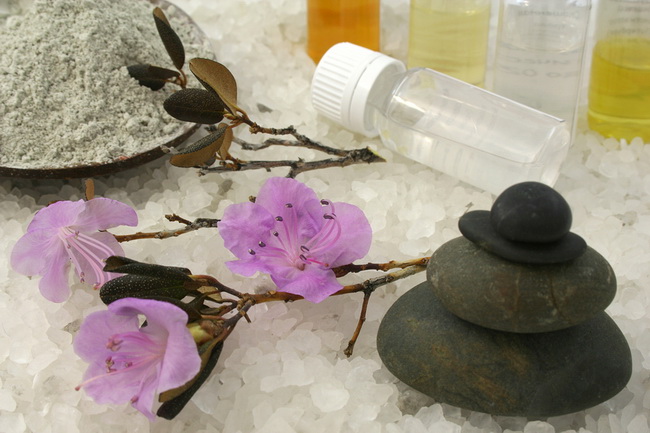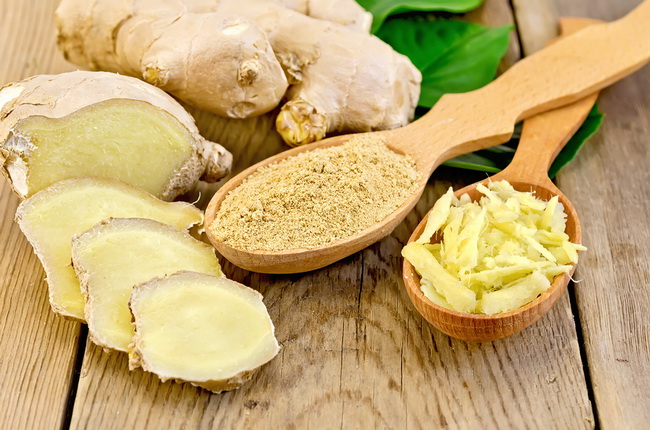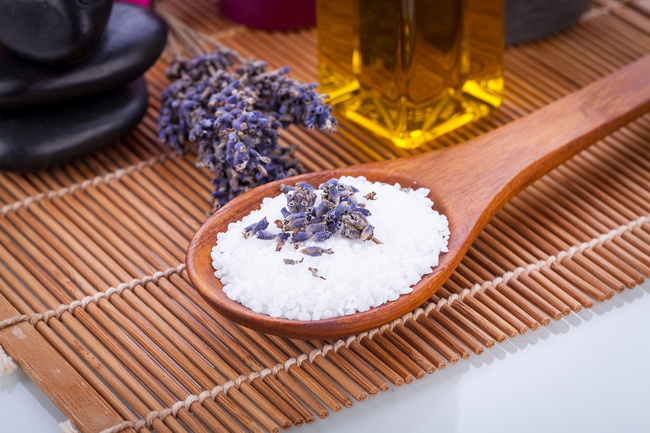- Make It Yourself Lavender Heart-Shaped Bath Bombs!
- 20 Things You Never Knew About “Down There”
- 12 Best Foods For Those Suffering From Arthritis Pain
- 12 Personal Hygiene Mistakes Almost Everyone Makes (Mom Never Told You About #4!)
- 15 Medicinal Plants And Herbs From The Cherokee People
- 12 Mind-Blowing Benefits Of Drinking Coconut Water During Pregnancy
- 12 Outstanding Winter Foods That Won’t Fatten You Up Like A Christmas Turkey
10 Super Relaxing and Cleansing Detox Bath Recipes (#5 is Luscious!)

Photo credit: bigstock.com
Do you love warm, relaxing baths? Who doesn’t?! Do you need to detox, but can’t seem to find the time? We know how that is. What if we told you that you could relieve stress, detox, and enjoy a relaxing bath all at the same time? It’s true!
Detoxing via bathing has been going on for centuries. Not everyone has a steam room handy! Imagine deep cleansing your body in the comfort of your own bathroom. You can also dim the lights or light a few candles, put on some relaxing music, and it’s almost like being at a spa – only cheaper.
Of course, if you suffer from any heart conditions or any other type of health problem, or if you are not sure that regular hot baths are for you, speak with your doctor before starting this or any detox program.
Since hot baths are so relaxing, you should probably do these about an hour or two before bedtime.
Frequently Asked Questions:
- Do detox baths burn calories? – You will sweat during your bath and afterwards, but not enough that you are actually burning calories.
- Are detox baths safe? – Detox baths are perfectly safe unless you suffer from a heart condition. Please consult your doctor if you have any questions about detox bathing.
- Can detox baths improve digestion? – A true detox program will do much more for your digestion than a detox bath will, but in terms of maintenance, after you have performed a full detox program, enjoying detoxifying baths will help to keep your digestion in perfect working order.
Are you ready to try out some fantastic detoxing bath recipes? We have 10 terrific choices so you can pick a different one every night of the week if you like!
1. Magnetic Clay Bath
There is a certain special type of clay that is said to contain small, magnetized pieces of an ore that draws out things from the body. Since metal attracts metal, it only makes sense that this type of clay can pull aluminum, arsenic, and mercury from the body. Each type of clay is specially formulated to remove a specific material from the body. You can use them in succession to ensure that you remove heavy metals from the body. This type of clay is sold under many names, but if you simply put “magnetic clay” in any search engine, you will find what you are looking for.
Continue to Page 2

Photo credit: bigstock.com
2. Ginger Detox Bath
This spice has been used for centuries to improve the immune system, soothe the digestive system and ward off viruses. Many people find that when they drink ginger tea regularly, they can avoid flu shots. Ginger has antioxidant, anti-viral, antibacterial, and anti-cancer compounds that have been well studied and researched. Ginger increases the body’s heat, which will help you sweat out toxins. Since it heats up the body so well, you might find that your skin turns red temporarily. You should also keep your bath water a bit cooler than you normally would to ensure that you do not overheat! Fresh ginger root is best, but even powdered ginger is good. Add about half a cup of freshly grated ginger root, or 1 heaping tablespoon of powdered ginger, to your bath water and soak for a minimum of 20 minutes.
3. Super Seaweed Detox
Although you might imagine going to the seashore and grabbing a big piece of seaweed, there is a much easier, and actually much better, way to use seaweed for a detox bath. There are premixed bags of Bladderwrack (a detoxifying herb), clay, and kelp. This mixture increases blood circulation and cleans the lymph fluids in the body by creating an electromagnetic agent that cannot be achieved in any other way. There are complete instructions with each package and if you follow them, you should be finished in 20 to 30 minutes. This bath is a delightful treat that you will want to repeat over and over.
4. Apple Cider Vinegar
OK, so it doesn’t smell as pretty as some of the other choices on this list, but when it comes to detox power, it has no equal. You can add a few drops of your favorite essential oil if the smell really bothers you. Apple cider vinegar is an excellent way to rebalance the pH of your skin and will give you super soft and supple skin. Since apple cider vinegar has antifungal and antimicrobial compounds, it can help stop skin fungus or problems such as rosacea. Add one cup of apple cider vinegar to your bath and soak for 20 to 30 minutes.
5. Oxygen Detox
You might not ever imagine putting hydrogen peroxide in your bath water, but this is a terrific detox bath, especially when you have a cold or the flu. It can also fight annoying skin irritations and allergies. Hydrogen peroxide has anti-viral and antibacterial compounds that can help remove any germs you might have picked up on the bus, subway, or train. Simply add 2 cups of hydrogen peroxide to your bath and soak for at least 30 minutes. If you are sick and have congestion, add one tablespoon of powdered ginger to help open up the respiratory system.
6. Epsom Salt and Clay Detox
Epsom salts are actually magnesium flakes, so they will not only infuse your body with some of that much-needed mineral, but also improve circulation while they draw out toxins. Bentonite clay has been used for hundreds of years to draw out toxins and impurities from the body. Mix the clay in a cup or bowl with some water until it becomes smooth and there are no more clumps. Then add the clay and two cups of Epsom salt to your bath. Stir it around until everything is well mixed, then jump in! Soak for 20 to 30 minutes and enjoy!
Continue to Page 3

Photo credit: bigstock.com
7. Essential Oil Detox
Turn your detox bath into a delightful sensory delight simply by adding some of your favorite essential oils to it. One of the great things about using essential oils is that you can change the oils to suit your current problem or desire. For example, if you feel completely drained at the end of the day, you should choose peppermint. If you have a cold, you might want to choose wintergreen or eucalyptus. For a splitting headache, lavender. See how this works? It is generally safe to add about 20 drops of essential oil to your bath water and soak for 20 minutes.
8. Baking Soda
Plain old sodium bicarbonate, known to most of us as baking soda, has anti-fungal compounds and super cleansing abilities. This will soothe and ease irritated skin. You will not believe how super soft your skin is after your bath! Dissolve ½ a cup of baking soda in your bath water and soak for 20 minutes.
9. Sea Salt Soak
With tons of trace minerals and calcium, sea salt is a terrific option for detoxifying. The calcium in sea salt is known for its ability to deep clean the pores and draw out toxins. Sea salt also contains bromide, a mineral that soothes irritated skin. Sea salt has iodine, which is vital for regulating the metabolic processes in the body. Add ½ a cup of sea salt to your bath water and stir until it is well dissolved. Soak for 20 to 30 minutes and you will feel amazing the next morning.
10. Himalayan Salt Detox Recipe
For a super detox soak, mix the following ingredients:
- ½ cup of Himalayan salt
- ¼ cup of baking soda
- 1/3 cup of apple cider vinegar
- 10 drops of your favorite essential oil
Dissolve the salt and baking soda in one quart of boiling water. Fill the tub, and then add the apple cider vinegar and essential oils. Now add the salt and soda. Soak for 30 to 40 minutes. Be careful when you get out of the bath, as you might feel lightheaded.
Note: As with any detox program, you might feel dizzy or lightheaded. Be very careful getting out of the bath and lie down or relax afterwards.
READ ALSO: 15 Signs It Is Time To Do A Detox (# 13, Who Knew?)
Extra Tips:
- Allow enough time for your body to detox and absorb minerals in the water, usually at least 20 minutes
- Since your skin’s pores are wide open after a bath, avoid toxic compounds afterwards, such as creams and lotions that contain chemicals.
- Detoxifying takes time; don’t try to detox in one bath or even in one week.
References:

































